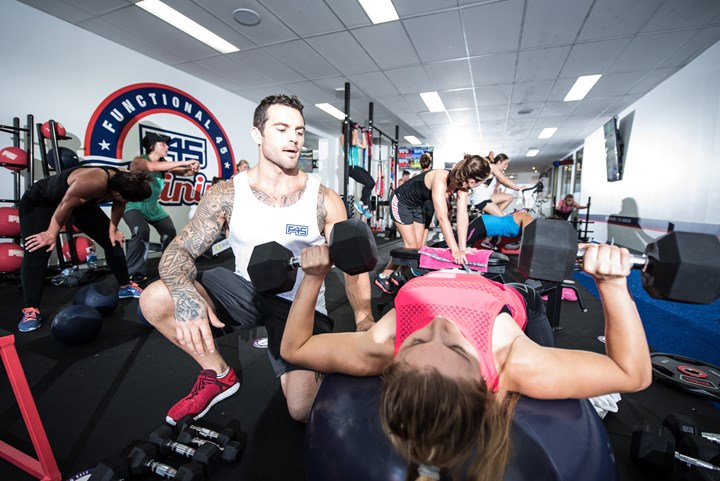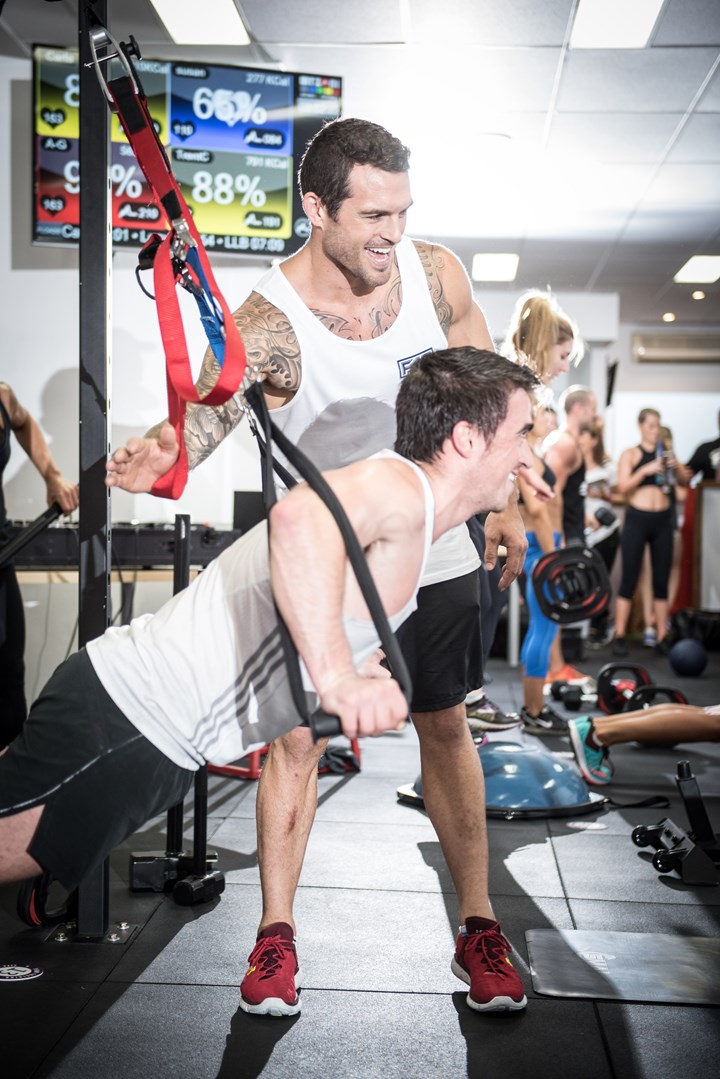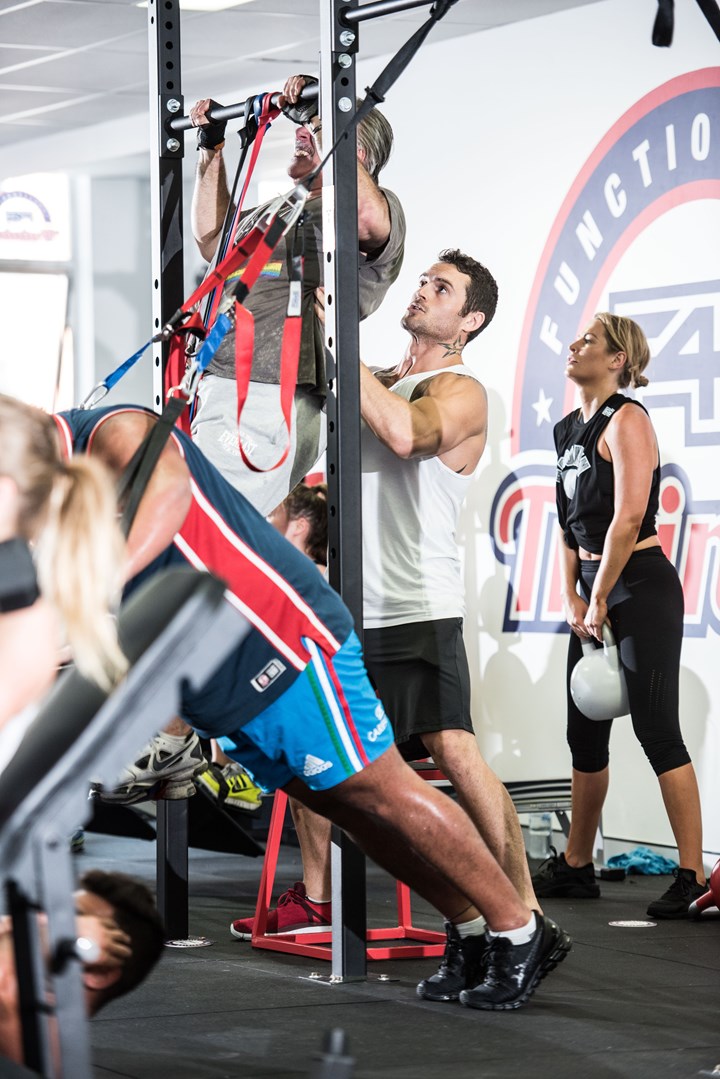I swear I’m the victim of some cruel Einsteinian joke. I understand that time is relative, but in the literal blink of an eye, the digital timer on the wall has dropped from nine seconds to two seconds. Right now, these 10-second breaks are more precious to me than the bottle of ’78 Grange my old man gave me for my 21st – and they’re zipping by at sadistic speed.
“Okay, weights up,” says the tattooed bloke at the front of the room. “Let’s go.”
I moan softly as I hoist a sandbag to my chest.
We’re 12 minutes into the workout and already an ominous rivulet of sweat is dripping from my nose. The class is packed with 30-odd other people in varying states of distress. It’s a Tabata-style set up: 20-seconds-on-10-off, a suite of up-tempo exercises ranging from overhead medicine-ball slams to TRX mountain-climbers to sandbag cleans. Sun pours through the windows as three industrial-size fans fight a losing battle to blast the stink of sweat out of the air.
The inked-up instructor paces the room, quietly dispensing pats on the back and nuggets of technical advice. There’s no hectoring, no chest-beating, no gimme-five-more-reps screeching – which is a good thing because I don’t have five more reps to give. I feel a tap between my shoulderblades: “Keep your chest up, Aaron. You’re doing well, mate.” The timer dings and I sink to my haunches. Blood is rushing in my ears. For a horrible moment I think I might pass out.
Through the roaring in my ears I hear my tormentor’s voice: “Okay, let’s get those weights up.” I’m precisely 12-and-a-half minutes into the 45-minute session and, without putting too fine a point on it, I’m getting my arse handed to me.
The man with the ink-blotted arms is Daniel Conn. He’s a busy man right now. His diary is packed. His phone rings constantly. His frequent-flyer mileage is astronomical.
On the morning we sit down outside a hole-in-the-wall cafe in Bondi, he’s fresh off a flight from Canada, where he’d cut the ribbon on a new F45 studio in Toronto. The day after our chat, he’s off to London for the opening of the UK’s first studio, then it’s on to the US where, yes, another gleaming F45 studio is launching in Santa Monica.
Two days after landing from that trip, he’s due to open his own F45 studio in Sydney’s Double Bay. He’s got a thumping party planned. The A-list of Sydney’s sporting and fitness scene will sweat it out in four back-to-back “Hollywood” classes, each fronted by Conn and backed by a DJ spinning tunes in the corner. It’s high-intensity interval training meets red-carpet nightclub – and it’s proven phenomenally successful.
“The whole thing’s just taken off,” says Conn, shaking his head. “We try not to act too surprised, but I guess you could say we’re pleased.” In Australia, Conn’s Double Bay studio will be the 100th to open. Around the globe, close to 300 franchises have sprung up. Conn rattles off some of the most recent ones: Solomon Islands, Philippines, India, Hong Kong . . .
In short, F45 is roaring. And Conn has his hand firmly on the wheel. His business card reads “F45 Athletic Director” but he is, in essence, the face, body and mind of the phenomenon. He trains the instructors, he programs the workouts, he models the exercises on the in-class flat-screens.
Little wonder he’s positively evangelistic about the training system. “We’re trying to create the best high-intensity interval team training in the world. We noticed people were walking into gyms and they didn’t know what to do. We’d see them looking at their phones or looking around at other people.” He shrugs: “Unless you got a PT, you weren’t going to get innovation and motivation. And when you don’t have innovation and motivation, you don’t get results.”
According to Conn, these are the twin precepts that have driven F45’s success. Innovation comes in the form of a bank of 2000 exercises that can be configured into an almost infinite number of workouts. Factor in an expanding repertoire of equipment (TRX rigs and rowing machines are recent additions to studios) and a growing number of classes (“Brooklyn”, a boxing class; “Firestorm”, a 27-station follow-the-leader set-up; and “Panthers”, a 14-station paired-resistance workout, have been added to the workout list) and Conn can confidently state that no two F45 classes will ever be the same.
Motivation, meanwhile, comes in the form of a fraternal atmosphere of shared suffering and achievement. Wander past an F45 studio before a class and you’ll see this in action, with crowds of lithe individuals – men and women – fist-bumping and back-slapping. Wander through the doors and the instructor will shake your hand, look you in the eye and remember your name throughout the session. This, in Conn’s estimation, is how you build a community. “And that’s the thing we’ve been most surprised about – how quickly this community has formed,” he says. “If you’re not mates before the class, you will be by the time it ends. Nothing’s more motivating than being part of a team.”
Innovation and motivation – these are the principles that have underscored F45’s success. They’re also principles that have saved Conn’s life.
Try this brutal body-weight workout
Conn describes himself as a “persistent kind of guy. If I start something, I finish it.” And so, when he realised early in life that his physicality on the rugby field could take him out of the tiny town of Goolma in NSW’s parched central-west, he poured his energy into his footy. “I became religious about training. I was one of those weird 13-year-olds who trained all the time. I was very disciplined – I think it’s the farming influence.”
The discipline paid dividends. At 15 he was offered a sporting scholarship to Sydney’s prestigious The King’s School. At 18, he was offered an NRL contract with the Canterbury Bulldogs. He signed on the dotted line and settled into a share house with two of the Bulldogs’ other young recruits – Johnathan Thurston and Sonny Bill Williams.
Conn spent six years in the NRL, moving from the Bulldogs to the Gold Coast Titans, before settling at the Sydney Roosters. Those years should have been a dream fulfilled. Instead, injury turned them into a twisted nightmare.
Ask him to list the injuries he suffered during those years and he cracks a wry grin: “Mate, how much time have you got?” Across his six years in the top grade he went under the surgeon’s knife on 16 occasions. Arthroscopies, reconstructions, a bilateral hernia, a fractured eye socket – the list rolls on. Conn shrugs: “It’s all pretty standard for an NRL player, really. Off-seasons aren’t rest time, they’re operation time.”
But the big one – the injury that would eventually force him from the game – was the protruding disc in his neck. It was an injury that built over time, a steady accumulation of knocks jolting the disc further and further out of place. Conn played on, enduring the mounting torment with painkillers. “It got to the point where I was getting needles for training sessions, for games. It got so bad I developed insomnia. I had constant pins and needles, constant headaches. It was horrible.”
At the end of the 2011 season, scans revealed the extent of the damage. The disc was no longer protruding – it was smeared down the side of his spine. “The doc said my disc looked like squeezed toothpaste. ‘Toothpasted’ was the word he used. It wasn’t a pretty image.” Conn was left with a stark choice: retire, or play on and risk being a cripple at the age of 30. He retired, then went under the scalpel one more time to have his C6 and C7 vertebrae fused together.
“I don’t like to dwell on negatives too much,” says Conn of the months after that surgery. But he admits he was mired in a dark place. “I couldn’t work for six months, I couldn’t even drive a car. I’d gone from earning good money with the Roosters to earning nothing. Zero.” Footy, his great talent, had given him a physical flogging, leaving him hobbled, broke and depressed.
Ironically, it would be another physical reckoning that would light the path out of the darkness.
Get shredded with this simple 30-minute workout
These days, Conn can’t feel the back of his neck. Nerve decompression from the surgery has killed off all sensations below the hairline. Tickle him with a feather and he won’t feel a thing. Is this why he’s been so extravagant with the ink that collars his neck? He laughs: “Nah, unfortunately the tattoos came first . . . ”
If those months after spinal surgery were the darkest of Conn’s career, then his meeting with F45 co-founder Rob Deutsch after Christmas in 2014 was a parting of the clouds. Conn had never done an F45 class. But he’d heard about them. And he knew a studio was opening in Bondi. As a qualified PT, maybe he could instruct a class or two a week? He gave Deutsch a call. “And a five-minute coffee turned into a three-hour man-date. At the end of the conversation Rob said, ‘Let’s shake on it now. You’re coming to work for us. We’re going to take this thing all the way.’” He grins: “So I started working for the big fella.”
F45 hasn’t just provided Conn with a career – it’s provided him with a new life. The depression he suffered has been banished. Partly, Conn credits this to the strict regimen of medication he now takes. (“I was always on and off meds while I was playing. The highs and lows of the NRL made it . . . interesting.”) More than the meds, however, Conn attributes his newfound equilibrium to the motivating atmosphere of the F45 fraternity. For him, it’s a simple equation: “When you’re around people who are physically active and in a healthy state of mind, it boosts your mental state as well.”
Physically, the changes have been equally dramatic. Back in his NRL playing days, when training revolved around heavy weights sessions, Conn packed 110 kilograms onto his 185-centimetre frame. “But it was a sloppy 110,” he admits. These days, F45 classes are the only training he does. He’ll snap out a morning class six days a week, Monday to Saturday. Often, he’ll back it up with an evening class. Sundays are his day of rest.
Adhering to the innovative variety of the F45 protocol, challenging his body with new movements, mixing high-rep weights with high-intensity cardio, he’s carved the extraneous weight off his frame – and feels a new man for it.
Strength tips from a man who lifts five times his body weight
Conn may present his inked-up frame as exhibit A in the case for F45’s ability to transform your life, but one anecdote does not a global fitness phenomenon make. F45 may be popular – but is it an effective training protocol? Yes, according to some of the leading voices in the Australian fitness industry. Says MH fitness adviser Greg Stark: “As far as group exercise training programs go, F45 is one of the better ones.”
Dan Williams, exercise physiologist and director of PT business Range of Motion, is even more effusive: “Intensity is the major predictor of how effective an exercise regimen is, so the real highlight of F45 is that it’s bringing intensity to the mainstream population.”
The praise, however, is qualified. Stark questions the 45-minute time frame, arguing that there’s “no research to suggest exercising at a high intensity for longer than 20 minutes brings any additional benefit and in many cases can increase potential risk of injury”. Conn counters by pointing out that for a 20-minute interval session to be effective, you have to be working at an incredibly high metabolic rate – something few lunch-break warriors can manage. “Besides,” he says, “we want people to have fun. We don’t want them broken the next day.”
Williams, meanwhile, points to the absence of high-load, low-rep strength training as a gap in the F45 protocol. “I know F45 has marketed itself as having the elements of CrossFit without the more complex lifting,” he says, “but I think strength training is super-important. The more muscle you have, the more functional you are, and the easier it is to maintain weight and avoid chronic conditions like osteoporosis.” Williams’ suggestion? “If you do a lot of F45 classes, supplement some strength work in there.”
Conn raises his eyebrows at the notion there’s not enough serious strength work in the F45 protocol. On a whim, he recently tested his 1RMs at powerlifting champ Sebastian Oreb’s gym in North Sydney. He snapped out a 260kg deadlift, a 200kg squat and 170kg bench press – numbers that easily outstripped the maximums he pushed during his playing days. “I’ve gained strength,” he says. “Mixing up all this high-intensity interval training has increased my movement, it’s helped my posterior chain function properly, and that’s allowed me to lift more.” He shrugs: “People say the weights in an F45 class aren’t heavy enough. I’m living proof they’re plenty heavy enough.”
So is he in better physical shape now than he was as a 25-year-old buck in the NRL? He throws his hands up: “Mate, way better shape.” He ticks the reasons off on his fingers: he’s no longer rocked by impact injuries on a week-to-week basis. And he no longer spends large chunks of the year recovering from surgery. Even his old injuries don’t give him too much grief any more. “With F45, I’m not lifting stupidly heavy weights, I’m not putting my body in bad positions, so everything’s functioning properly again. I know that word – ‘functional’ – gets bastardised a bit, but that’s how I feel. I’m functional again.”
I ponder these words as I shuffle out of the F45 studio after my class. My shirt’s saturated with sweat, my legs are twitching uncontrollably. Do I feel “functional”? God no. I feel like I’ve been worked over with a pair of baseball bats then pushed off the North Bondi cliffs into the roiling surf below.
But within an hour comes a glittering endorphin rush that leaves me whistling at my desk. By the time I wake the next morning, my body feels light and fresh: no aching joints, no strained muscles. Perversely, I find myself craving another communal 45-minute endorphin hit.
And herein lies the secret of the system’s phenomenal popularity. It’s a simple physical equation with an appealing prize. Take a 45-minute block of suffering, add some technical innovation, multiply by the motivating force of a group and – eureka! – you too can feel functional again.
Change up your chest routine with this high-intensity workout
















